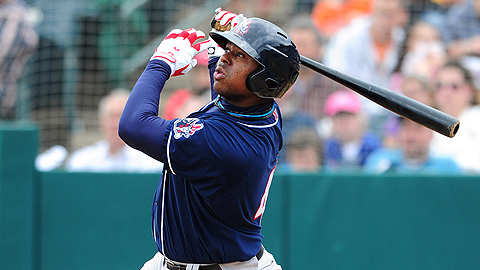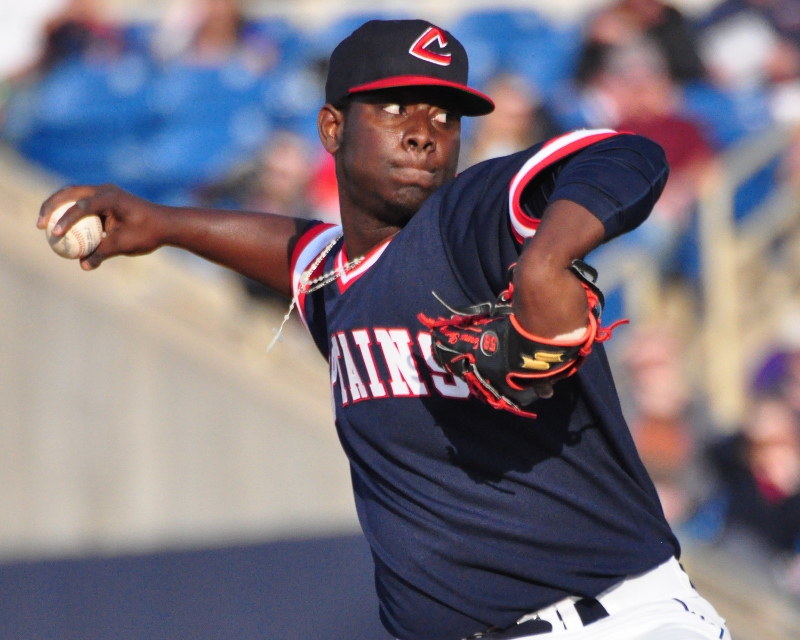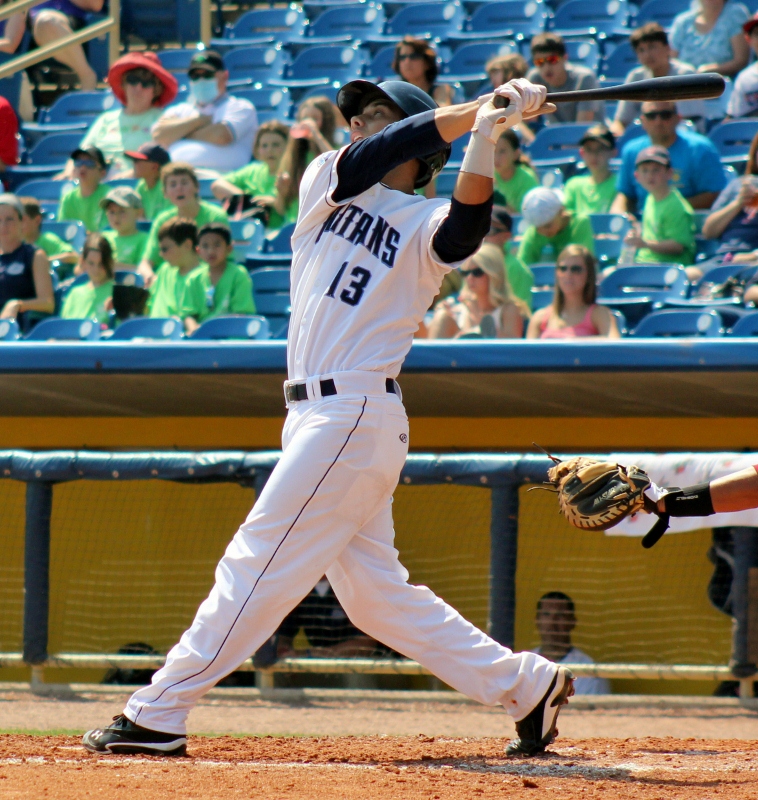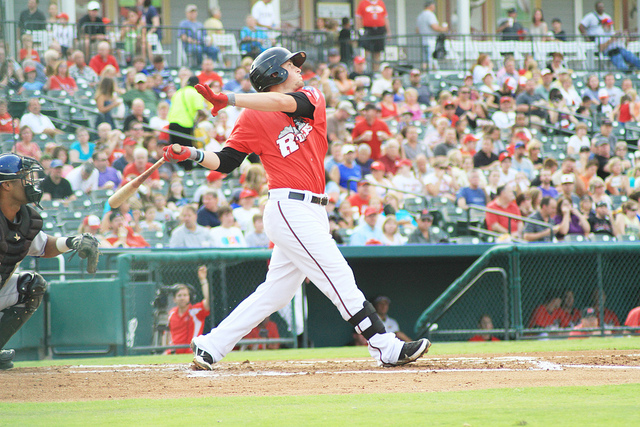 Indians Archive
Indians Archive  Indians Prospect Countdown: #40-36
Indians Prospect Countdown: #40-36
 There's no stopping this train now that it is out of the station. In today's always-exciting installment of the Indians Prospect Countdown, we're going to take a look at a pair of first baseman who are new to the organization as of this offseason, coming over from other AL rivals. We're also going in-depth with a pitcher and a catcher who had disappointing 2012 campaigns with the Lake County Captains and are looking to rebuild their value in the organization, and a flamethrowing righty reliever who just cannot seem to stay healthy and on the mound.
There's no stopping this train now that it is out of the station. In today's always-exciting installment of the Indians Prospect Countdown, we're going to take a look at a pair of first baseman who are new to the organization as of this offseason, coming over from other AL rivals. We're also going in-depth with a pitcher and a catcher who had disappointing 2012 campaigns with the Lake County Captains and are looking to rebuild their value in the organization, and a flamethrowing righty reliever who just cannot seem to stay healthy and on the mound.
40. Mike McDade, 1B
DOB: 5/8/1989
Height/Weight: 6-1/250 lb.
Bats/Throws: Switch/Right
Acquired: Via trade in 2012 for Esmil Rodgers
2012 Stats: .285/.360./445 with 19 HR and 67 RBI between AAA Las Vegas and AA New Hampshire
Scouting Report: Acquired in the Esmil Rodgers deal, McDade is a first baseman who will turn 24 this May. He was originally drafted out of high school in the 6th round of the MLB draft back in 2007, and had spent his entire career in the Blue Jays organization. Last season was his first exposure to AAA pitching, and in 18 games with Las Vegas he posted an .885 OPS and popped a pair of HR. Small sample size, but encouraging nonetheless.
McDade’s career minor league numbers are underwhelming for a 1B; he’s hit .265/.323/.420 with 76 HR in 630 games. But since the 2009 season in Lansing, McDade has been a different player. After hitting just 6 HR in his first two MiLB seasons, McDade hit 16, 21, 16 and 17 bombs from the 2009-2012 season. So 70 of McDade’s HR have come in his last 479 games, a much better ratio. Still not quite what you’re looking for in a middle of the order 1B, but better.
McDade is a switch hitter, and actually has better splits as a lefthanded hitter. Over the last two seasons, he’s posted an .819 OPS against righthanded pitching and a .709 OPS against southpaws. That OPS difference is fueled by the fact that 24 of McDade’s 32 HR have come from the left side of the plate.
McDade is on the 40-man roster, and his spot survived every time the Indians added a new player even as guys like Russ Canzler and Thomas Neal were being DFA’d. The Indians clearly like what they have in McDade, and feel like he has a future in the organization. He’ll be in the mix for at bats at 1B in Columbus in 2013, and he should fare well in the high-octane offensive environment that is Huntington Park. His road to the corner of Carnegie and Ontario is unclear with the presence of Mark Reynolds and Nick Swisher, but Reynolds was signed to a one-year deal, so the Indians could easily find themselves in need of a 1B/DH come 2014, and McDade will be waiting in the wings.
Glass half-full: A 2nd division starter at 1B
Glass half-empty: McDade doesn’t develop enough power to be an everyday 1B
 39. Felix Sterling, RHP
39. Felix Sterling, RHP
DOB: 3/15/1993
Height/Weight: 6-3/200 lb.
Bats/Throws: Right/Right
Acquired: International free agent in 2009
2012 Stats: 7-8, 5.65 ERA with 102 K and 47 BB in 114 2/3 IP between Rookie Arizona and Lake County
Scouting Report: Sterling had a rough 2012 season, to the point where he was sent down to Arizona from Lake County in the middle of the season to try and find himself. Between his two stints in the Midwest League, he went 4-8 in 18 starts with a 6.58 ERA, really struggling with the Captains. He’s a big, strong righty who is still extremely raw as a pitcher. He can still afford to put a few pounds onto his 6’3” frame, and his velocity might add a tick or two as he gets stronger.
Velocity isn’t the problem for Sterling, as his above-average fastball sits comfortably in the low to mid-90’s. His best secondary offering is his slider, a pitch that is still inconsistent but has flashed plus. If Sterling can sharpen the slider and get it on a more consistent plane, then it could develop into an out pitch. It can get a little slurvy at times though, as the spin and velocity are not consistent from pitch to pitch. In addition to the slider, Sterling is developing a changeup, but at this stage in his career he has very little feel for the pitch. Development of the changeup is key to Sterling’s future, as it’s a badly-needed pitch for him to be able to give hitters something to think about besides the fastball and hard slider. If he wants to stick in the rotation, he’ll need a that third pitch that provides some separation in velocity.
Talking to a National League scout in June of last year, I got some very negative reviews of Sterling. The scout was pretty sure Sterling was a reliever long-term, as he didn’t have the arsenal or the command to stick in the starting rotation. If that’s true, Sterling’s prospect status takes a huge hit, and the 2012 numbers would certainly suggest that the scouting report was accurate. Sterling will still only be 20 at the beginning of the 2013 season, so there’s time for him to round out his arsenal and stick in the starting rotation. But he’s going to have to make some strides this year, both in his numbers on the field and in the scouting reports. He’ll likely find himself back in the Midwest League, and if he can’t make some significant improvements in his secondary pitches then he’s going to have a season similar to 2012.
Glass half-full: He improves his slider and changeup and makes it as a mid-rotation starter
Glass half-empty: A two-pitch power reliever
 38. Alex Lavisky, C
38. Alex Lavisky, C
DOB: 1/13/1991
Height/Weight: 6-1/200 lb.
Bats/Throws: Right/Right
Acquired: 8th round pick in the 2010 draft
2012 Stats: .246/.314/.404 with 12 HR and 49 RBI in 93 games for Lake County
Scouting Report: Lavisky was selected in the 8th round of the 2010 draft out of St. Ed’s high school in Cleveland, and the Indians paid the local product an even $1 million to sign, breaking his commitment to Georgia Tech. Lavisky grew up an Indians fan, and was thrilled to be selected by his hometown team. The Indians were aggressive with Lavisky, assigning him straight to low-A Lake County in 2011. High school catchers don’t typically go straight to low-A, but the Indians were convinced that Lavisky was talented and mature enough to handle the assignment. He struggled with the Captains, hitting just .207/.251/.391 with 8 HR in 49 games for Lake County. He finished the rest of the 2011 season in Mahoning Valley, and ended the 2011 season with a combined OPS of just .621. Back in the Midwest League for all of 2012, Lavisky was better but still struggled. He hit 12 HR and put up a .718 OPS, but struck out 95 times in 93 games. His K rate actually decreased from 2011 to 2012, as he racked up 127 whiffs in 117 games in 2011.
Lavisky has impressive raw power and plus bat speed. He’s a strong, athletic kid and really puts on a show in batting practice. He’s always going to be a guy with some swing and miss in his game, but still needs to improve his contact rate. Lavsiky drew 34 walks last season, up from 29 in 2011 so while he still needs to work on pitch recognition and selection, there was clear improvement from his first professional season. He has all the tools to be a middle of the order hitter, but he needs to make more contact and do a better job with offspeed stuff.
Defensively, Lavisky has everything you want in a catcher. He’s big, strong and durable, and an outstanding leader. He has an above average arm and quick, clean actions behind the plate. He moves well and does a very nice job blocking pitches in the dirt. He communicates well with pitchers, and they like throwing to him. He’s a very good receiver, and he can thank his high school teammate Stetson Allie for that; Allie was drafted as a pitcher having hit triple digits in high school but has already been moved to 3B as a professional due to his control problems. Lavisky handled Allie all through high school, and getting an opportunity to catch high-90’s heat every day in practice conditioned Lavisky well for life as a professional catcher.
Lavisky had another somewhat disappointing season, but when you look into the numbers there are some encouraging trends. Lavisky improved his numbers across the board from 2011 to 2012; his batting average, OBP, SLG, walk rate and K rate all improved in his repeat tour of the Midwest League. The tools are there, but the performance needs to continue to improve if Lavisky is going to play up to his lofty draft status. I’ve said it before, but pitch selection and recognition are crucial to Lavisky’s development. If he can start laying off of pitches out of the zone and pick out pitches that he can drive, things could turn around in a hurry for the kid from Cleveland. Lavisky turned 22 in January, and will likely play all of 2013 in the difficult hitters environment of the Carolina League with the Carolina Mudcats. He needs to build on the relative success of 2012 and have another season where his numbers improve across the board. If so, he’ll take a nice little leap in this list come next offseason.
Glass half-full: A power hitting catcher with plus defense
Glass half-empty: His contact issues intensify, and he never hits enough to make it to The Show
 37. Bryce Stowell, RHP
37. Bryce Stowell, RHP
DOB: 9/23/1986
Height/Weight: 6-2/205 lb.
Bats/Throws: Right/Right
Acquired: 22nd round pick in the 2008 draft
2012 Stats: 2-1, 2 saves with a 3.72 ERA, 44 K and 9 BB in 29 IP for Akron
Scouting Report: On pure talent, Stowell easily ranks in the top-15 of this list. He has electric stuff, and has struck out a remarkable 12.3 batters per 9 IP in his minor league career (280 K in 205 IP). Selected in the 22nd round out of UC Irvine in 2008, the Indians tried to keep Stowell in the starting rotation, but durability and command issues forced him to a bullpen role fairly early on in his professional career. His delivery was a little choppy coming out of college, and with some refinements the Indians were able to smooth out some of the kinks and Stowell picked up even more velocity after his professional debut. He has closer stuff, and talent-wise Stowell would be a lock to pitch in the back end of a major league bullpen. Unfortunately, due to various arm ailments Stowell has only been able to throw a total of 67 2/3 innings over the past two seasons, and those injury issues have stalled Stowell’s once meteoric rise through the system.
Stowell has one of the best fastballs in the organization, a true plus-plus offering that sits in the high 90’s and has touched triple digits. It’s his bread-and-butter pitch, one that helps him dominate hitters on pure velocity alone. He compliments the fastball with a slider and a changeup, with the slider being the better offering of the two. It’s a sharp offering with late life and excellent tilt, and helps him dominate righthanded hitters. The changeup is more of a show pitch than an effective third offering, but it’s a good change of pace pitch to give hitters something to think about besides the higher-velocity fastball and slider.
Stowell missed almost the entire month of July last year, and just can’t seem to stay healthy for an entire season. He’s had elbow and shoulder issues, but hasn’t gone down with a major surgery yet. When he’s healthy, he’s one of the best pitchers in the organization. His outstanding velocity plays up even more due to a deceptive delivery that has Stowell bring his hands high above his head, and features a big leg kick that helps hide the ball from the hitter till the last possible second. But if he can’t stay on the mound, it’s all for naught. Stowell will pitch the 2013 season as a 26-year old, and we’re approaching now-or-never time for the powerful righty. If healthy, he could pitch in Cleveland in 2013. But that’s a big if, and it keeps him ranked well below his actual talent level on our countdown this offseason.
Glass half-full: An elite setup arm in the backend of a major league bullpen
Glass half-empty: Injured and out of baseball
 36. Chris McGuiness, 1B
36. Chris McGuiness, 1B
DOB: 4/11/1988
Height/Weight: 6-1/210 lb.
Bats/Throws: Left/Left
Acquired: Via the Rule 5 draft from Texas in 2012
2012 Stats: .268/.366/.474 with 23 HR and 77 RBI for AA Frisco
Scouting Report: McGuiness was originally a 13th round pick by the Boston Red Sox in 2009 out of The Citadel, and he comes to the Indians organization sporting a career .814 OPS in 350 minor league games. He only played in 55 games in 2011, but bounced back to have the best season of his career last year with AA Frisco, hitting 23 HR and putting up a solid .840 OPS. McGuiness was sent to the elite Arizona Fall League this offseason, and he responded by hitting .283/.370/.467 with 4 HR and 27 RBI, propelling him to the AFL MVP Award. It was an outstanding season for the 24-year old 1B, and it was a surprise to see the Rangers leave him off of their 40-man roster this past offseason. The Indians snatched him up to help fill their 1B/LF void, but that void is suddenly non-existent after the unusual spending spree that Chris Antonetti and company went on this winter.
McGuiness has average power and a very good approach. He’s a patient hitter with a good walk rate and a .373 minor league OBP. He has plus power to the right side of the field, but below average pop to the opposite field. McGuiness can sometimes get into trouble when he gets too pull happy, as his hips and right shoulder can fly open way too early and leave him susceptible to pitches on the outer half of the plate. Defensively, McGuiness is a solid if unspectacular 1B who’s never played another position in his minor league career. He’s a good athlete with good footwork around the bag, but will probably never be a Gold Glover. He has a below-average arm, which won’t really be a detriment at 1B but would be if the Indians tried to move him to the OF on a part-time basis.
When he was acquired from the Rangers in the Rule 5 Draft, McGuiness seemed likely to stick on the 40-man at least, and had a shot at making the 25-man roster out of Goodyear as a 1B/LF/DH option. The signing of Mark Reynolds, Nick Swisher and Michael Bourn makes that into a real long shot. If he doesn’t make the 25-man roster, McGuiness will have to be offered back to the Rangers, and that seems almost inevitable at this point. It will be interesting to see if the Indians like McGuiness enough to try and work out a trade with Texas, or if they just give him back to the Rangers at the end of Spring Training. The Indians still don’t have a lot of depth at 1B and LF, particularly in the upper levels of the system, so McGuiness would be a nice option to have waiting in the wings in AAA Columbus.
Glass half-full: A part-timer at 1B/LF/DH with a little pop
Glass half-empty: He goes back to Texas after missing out on the Indians 25-man roster out of Goodyear
- NBA Announces 2013-2014 Schedule
- Browns Ink Sharknado
- Sharknado A No-Show For Rookie Camp
- Trent Richardson Out Until Training Camp
- Browns Sign Brandon Jackson
- Carrasco Suspended Eight Games
- Browns Add to Wide Receiver Depth with David Nelson
- Browns Need to Learn from Past Draft Mistakes
- Browns Release Chris Gocong and Usama Young
- Browns Missing on Grimes Disappointing, But Not The End
The TCF Forums
- Chris Grant's first 3 drafts
Kingpin74 (Tuesday, January 21 2014 10:13 AM) - The 2014 Offseason Thread
googleeph2 (Tuesday, January 21 2014 9:36 AM) - 2015 Recruiting
furls (Tuesday, January 21 2014 6:57 AM) - Mike Brown
YahooFanChicago (Monday, January 20 2014 11:15 PM) - Movies coming out
HoodooMan (Monday, January 20 2014 9:34 PM) - 2014 Hoops Hockey Hijinx
jpd1224 (Monday, January 20 2014 4:44 PM) - 2014 Recruiting
jclvd_23 (Monday, January 20 2014 2:26 PM) - Wish List - #4 Pick
Hikohadon (Monday, January 20 2014 1:26 PM) - Official- Browns Coach Search/Rumors
OldDawg (Sunday, January 19 2014 6:48 PM) - #1 overall pick Anthony Bennett
TouchEmAllTime (Sunday, January 19 2014 1:28 PM)


